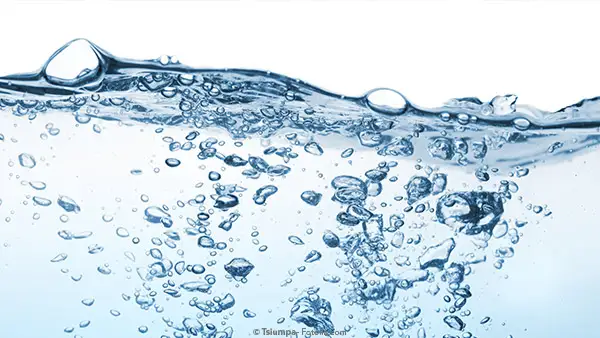Amazing new technology extracts oxygen from water using magnets
Making oxygen in low gravity environments, such as aboard the International Space Station, is challenging and resource intensive.

[Aug 24, 2022: Peter Thorley, University of Warwick]
Making oxygen in low gravity environments, such as aboard the International Space Station, is challenging and resource intensive. (CREDIT: Creative Commons)
New study involving University of Warwick chemist demonstrates method of using magnets to generate oxygen from water.
Making oxygen in low gravity environments, such as aboard the International Space Station, is challenging and resource intensive.
This method could aid the development of technology for future long-term space missions.
A potentially better way to make oxygen for astronauts in space using magnetism has been proposed by an international team of scientists, including a University of Warwick chemist.
The conclusion is from new research on magnetic phase separation in microgravity published in Nature’s affiliated npj Microgravity journal by researchers from the University of Warwick in the United Kingdom, University of Colorado Boulder and Freie Universität Berlin in Germany.
Related Stories:
Keeping astronauts breathing aboard the International Space Station and other space vehicles is a complicated and costly process. As humans plan future missions to the Moon or Mars better technology will be needed.
Lead author Álvaro Romero-Calvo, a recent PhD graduate from the University of Colorado Boulder, said: “On the International Space Station, oxygen is generated using an electrolytic cell that splits water into hydrogen and oxygen, but then you have to get those gasses out of the system. A relatively recent analysis from a researcher at NASA Ames concluded that adapting the same architecture on a trip to Mars would have such significant mass and reliability penalties that it wouldn’t make any sense to use.”
Dr Katharina Brinkert of the University of Warwick Department of Chemistry and Center for Applied Space Technology and Microgravity (ZARM) in Germany said: “Efficient phase separation in reduced gravitational environments is an obstacle for human space exploration and known since the first flights to space in the 1960s.
The injection and displacement of air bubbles are shown as a function of time. (CREDIT: npj Microgravity)
This phenomenon is a particular challenge for the life support system onboard spacecraft and the International Space Station (ISS) as oxygen for the crew is produced in water electrolyzer systems and requires separation from the electrode and liquid electrolyte.”
The underlying issue is buoyancy.
Imagine a glass of fizzy soda. On Earth, the bubbles of CO2 quickly float to the top, but in the absence of gravity, those bubbles have nowhere to go. They instead stay suspended in the liquid.
In a, the larger bubble approaches the smaller in its path toward the magnet, reaching the point of closest proximity in b. In c, the smaller bubble is accelerated by the wake of the larger, reducing its speed once the wake moves away in d. The red arrow indicates the velocity of the smaller bubble as the larger one drags it. (CREDIT: npj Microgravity)
NASA currently uses centrifuges to force the gasses out, but those machines are large and require significant mass, power, and maintenance. Meanwhile, the team has conducted experiments demonstrating magnets could achieve the same results in some cases.
Although diamagnetic forces are well known and understood, their use by engineers in space applications have not been fully explored because gravity makes the technology difficult to demonstrate on Earth.
Enter the Center for Applied Space Technology and Microgravity (ZARM) in Germany. There, Brinkert, who has ongoing research funded by the German Aerospace Center (DLR), led the team in successful experimental tests at a special drop tower facility that simulates microgravity conditions.
Here, the groups have developed a procedure to detach gas bubbles from electrode surfaces in microgravity environments generated for 9.2s at the Bremen Drop Tower. This study demonstrates for the first time gas bubbles can be ‘attracted to’ and ‘repelled from’ a simple neodymium magnet in microgravity by immersing it in different types of aqueous solution.
The research could open up new avenues for scientists and engineers developing oxygen systems as well as other space research involving liquid-to-gas phase changes.
Dr Brinkert said: “These effects have tremendous consequences for the further development of phase separation systems, such as for long-term space missions, suggesting that efficient oxygen and, for example, hydrogen production in water (photo-)electrolyser systems can be achieved even in the near-absence of the buoyant-force.”
Professor Hanspeter Schaub of University of Colorado Boulder said: “After years of analytical and computational research, being able to use this amazing drop tower in Germany provided concrete proof that this concept will function in the zero-g space environment.”
‘Magnetic phase separation in microgravity’ is published in npj Microgravity.
For more science news stories check out our Innovations section at The Brighter Side of News.
Note: Materials provided above by University of Warwick. Content may be edited for style and length.
Like these kind of feel good stories? Get the Brighter Side of News' newsletter.
Joseph Shavit
Head Science News Writer | Communicating Innovation & Discovery
Based in Los Angeles, Joseph Shavit is an accomplished science journalist, head science news writer and co-founder at The Brighter Side of News, where he translates cutting-edge discoveries into compelling stories for a broad audience. With a strong background spanning science, business, product management, media leadership, and entrepreneurship, Joseph brings a unique perspective to science communication. His expertise allows him to uncover the intersection of technological advancements and market potential, shedding light on how groundbreaking research evolves into transformative products and industries.



